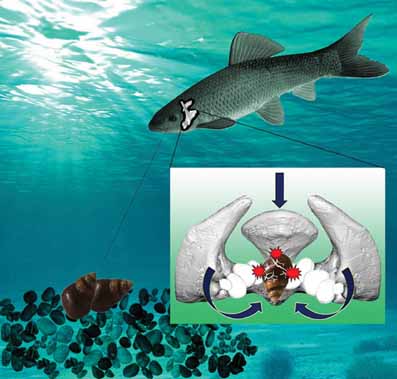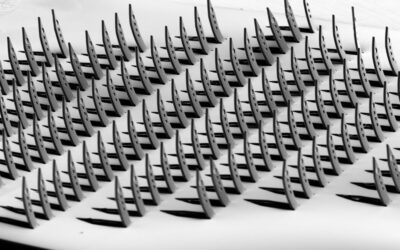Evolution equipped many organisms such as snails, crabs, and lobsters with hard and strong shells to protect their soft and vulnerable bodies. The excellent mechanical properties of these bioarmors attracted considerable attentions and inspired a number of biomimetic projects. Until now, researches mainly focused on the armors of the defenders but overlooked the attackers. But the invasive apparatuses of attackers may also contain design strategies with equivalent value as those of the defenders to the synthesis of novel materials.
 This was focus of a Chinese research project. Chong He, et al., choose the black carp for their study, a freshwater fish that feeds on shelled molluscs by crushing their hard shells. The question of the researchers was: why are black carps able to crush hard mollusk shells at ease? Do the teeth of black carp possess particular structures or enable the mechanical properties them to conquer the hard mollusk shells?
This was focus of a Chinese research project. Chong He, et al., choose the black carp for their study, a freshwater fish that feeds on shelled molluscs by crushing their hard shells. The question of the researchers was: why are black carps able to crush hard mollusk shells at ease? Do the teeth of black carp possess particular structures or enable the mechanical properties them to conquer the hard mollusk shells?
To quantify the mechanical properties of the pharyngeal teeth particularly compared to those of the mollusk shells, mechanical characterizations were carried out on the fish teeth. Chong He, et al., found that the enameloid, the most outer layer of pharyngeal teeth, possesses similar elastic modulus and hardness in comparison to those of the pond snail shells. The superior properties must rely on the structure rather than the material.
To shed light on the mechanics of black carp teeth crushing mollusk shells, they conducted parametric studies on the geometry of the shells by means of finite element method. The results show that for given teeth whether a shell is crushable or not actually depends on the shell radius and thickness. A mechanics-based predation map for black carp was constructed in terms of these two parameters. The Chinese researchers conclude that their results not only shed light on the mechanism of pharyngeal teeth crushing shells but also may serve as a significant guideline for the design of new protective or invasive structural materials.

















